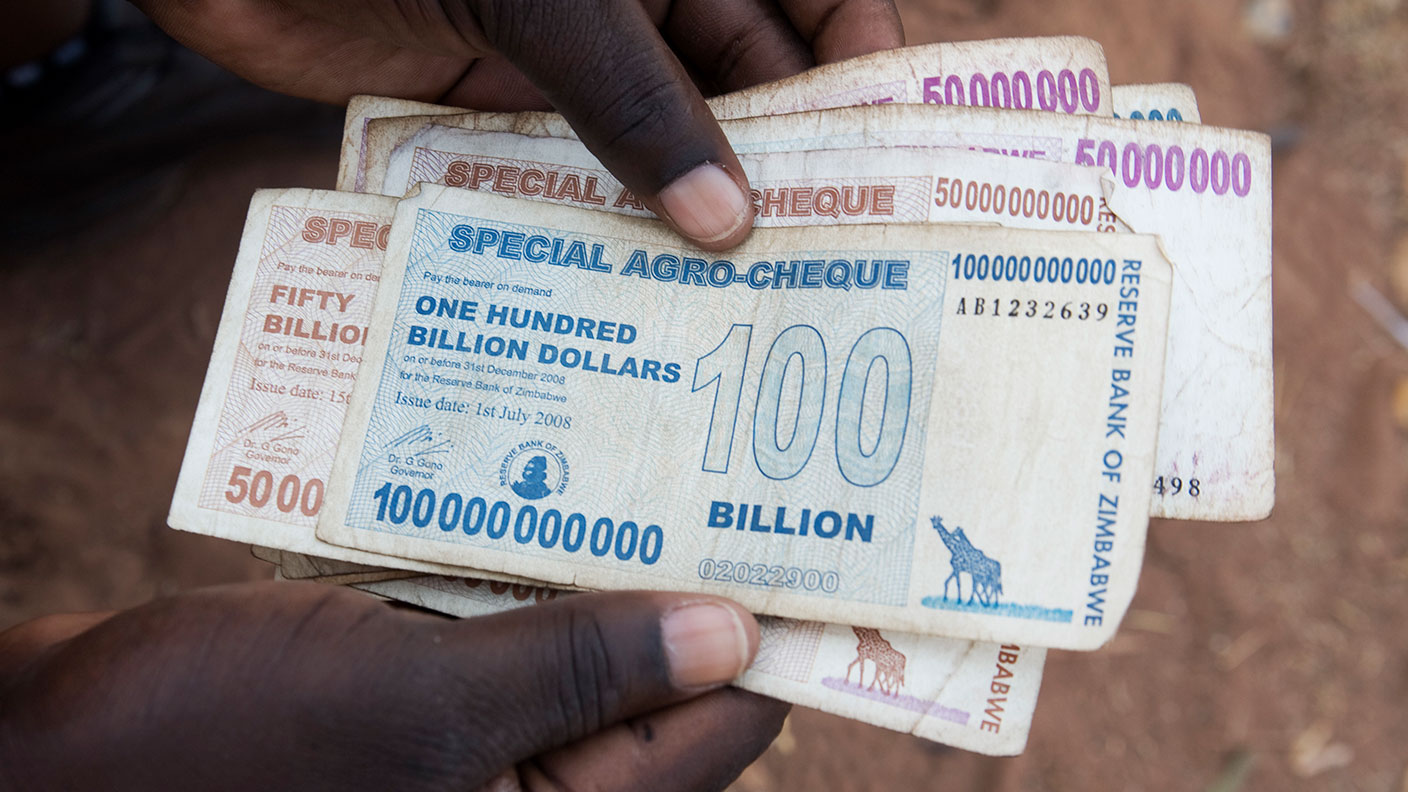What is hyperinflation and could it happen here?
The Bank of England has been accused of the kind of money-printing that could lead to Zimbabwe-style hyperinflation. But that's very unlikely to happen here, says John Stepek. Here's why.


When people discuss the risks involved in governments printing money, the spectres of Zimbabwe and Weimar Germany are never far from the discussion.
Inflation is certainly a risk of money printing. Indeed, to an extent, it’s the goal. But is hyperinflation – which goes far beyond inflation – really a scenario we should be concerned about in developed economies such as the UK and the US?
Let’s have a look at what actually causes hyperinflation – and what that can tell us about how likely we are to end up there.
MoneyWeek
Subscribe to MoneyWeek today and get your first six magazine issues absolutely FREE

Sign up to Money Morning
Don't miss the latest investment and personal finances news, market analysis, plus money-saving tips with our free twice-daily newsletter
Don't miss the latest investment and personal finances news, market analysis, plus money-saving tips with our free twice-daily newsletter
Hyperinflation is about a lot more than money
The first point to make is that hyperinflation is qualitatively different to inflation. During inflation, prices are going up. They may even be going up a lot (for example, inflation in Britain in the 1970s went as high as 26%).
But in hyperinflation, the speed of the increase in prices is so extreme that measuring it is almost irrelevant. I’ve seen one estimate suggesting that inflation in Weimar Germany peaked in 1923 at 29,500%... a month (which would mean prices doubling once every four days). And Zimbabwe in 2008 was even worse.
So hyperinflation really describes a situation where the currency is essentially meaningless. It’s the collapse of an economy and its currency, rather than simply a tough period.
As Ray Dalio of Bridgewater points out in his book on debt cycles (A Template For Understanding Big Debt Crises), after hyperinflation “the currency never recovers its status as a storehold of wealth”. Or, to quote the title of Adam Fergusson’s history of the Weimar collapse, hyperinflation is quite literally “When Money Dies”.
Economist John Maynard Keynes (as ever) had a pretty pithy way of summing up the issue. Under hyperinflation, “all permanent relations between debtors and creditors, which form the ultimate foundation of capitalism, become so utterly disordered as to be almost meaningless; and the process of wealth-getting degenerates into a gamble and a lottery.”
I think that most of us would agree that there’s a difference between 1970s Britain and 1920s Weimar Germany or 2000s Zimbabwe or 2010s Venezuela.
So what drives such a catastrophic collapse? Behavioural analyst James Montier, who works for US asset manager GMO, wrote a good paper on hyperinflationary episodes in 2013.
The key thing to understand is that hyperinflation is not the result of money printing alone. In fact, it’s more correct to say that rampant money printing is a side effect of the conditions that give rise to hyperinflation.
The three key factors that create hyperinflation
So what are those? There are three main factors that contribute, says Montier.
Firstly, you need a huge supply shock – in other words, there needs to be a sharp reduction in the productive capacity of the economy. That means there is not as much “stuff” to go round, so that demand outstrips supply, which is inflationary.
You can see this in all the big famous hyperinflations, and also in the less well-known ones. In Weimar Germany, the supply shock was World War I (hyperinflation often arises in the aftermath of war). In Zimbabwe, the supply shock was the destruction of agricultural production through cronyism and mismanagement.
Secondly, a country needs to have a lot of obligations that need to be paid in a foreign currency – possibly debt that is denominated in an overseas currency (often US dollars, or in the olden days, gold), or simply a need to make payments abroad that the country’s productive capacity can’t easily accommodate.
This makes it impossible for a country to simply print money to get rid of its obligations, and it encourages money to flee the country, which in turn leads to pressure to print even more, which drives down the value of the currency, and so on.
Again, if you look at historical hyperinflations, all of them involve countries or regimes with large overseas obligations. In Weimar Germany, it was reparations, denominated in gold. In Zimbabwe, the big issue was that the government made such a mess of the economy that it had to import food (which had to be paid for in US dollars).
Making it simpler, “good” money flows out of the country while the “bad” money stacks up at home (eventually in wheelbarrows).
Thirdly, you need a vicious circle to drive prices up and sustain them at the extraordinary levels seen in a hyperinflation. This “transmission mechanism” comes in the form of rising wages.
Prices soar, workers can’t pay for goods, so they demand and get pay rises, which drives up prices further, and so on. You tend to get price and wage controls imposed at this point but obviously they don’t work, because “black market” rates take over.
Why the UK is highly unlikely to see hyperinflation
In short, if you look at these factors, it’s clear that while money printing is the mechanic by which hyperinflation takes place, the money printing is the result of a series of other conditions that cause the collapse of an economy’s productive capacity.
Put very simply, the economy is no longer able to produce enough to both service its debts and meet the needs of the population. The remaining productive capacity goes on meeting the most important obligations while the other needs are met with increasingly worthless IOUs.
It’s like having a big mortgage, then losing your job. You keep paying the mortgage so you have a roof over your head, but start handing out IOUs to pay the rest of your bills. Clearly, this couldn’t happen in real life, but if it did, it wouldn’t take long before all your other creditors were demanding “real” money.
So this is why the idea that printing money = hyperinflation is flawed. Let’s look at the UK, for example. At the moment, the UK has certainly suffered a severe supply shock, but coronavirus has imposed a demand shock to match.
And when demand comes back, there is very little to stop supply from rising to meet it. We’re not looking at the sort of productive capacity destruction caused by extreme social unrest or war.
The UK’s other big advantage is that it still issues debt in its own currency and people will buy it. So Britain does not have the same issues with obligations denominated in overseas currencies that have historically gone hand in hand with hyperinflation.
So the good news is that hyperinflation in the UK seems highly unlikely. The bad news is that high inflation – rather than a hyperinflationary collapse – is much more feasible. Indeed, at some level it’s part of the plan for getting rid of all this debt. We’ll have more on that in the week ahead.
In the meantime, if you are interested in learning what past market crashes might have to teach us about the reaction to the coronavirus crisis, subscribe to MoneyWeek magazine. You’ll get your first six issues free.
• This article was first published in April 2020
Get the latest financial news, insights and expert analysis from our award-winning MoneyWeek team, to help you understand what really matters when it comes to your finances.
John Stepek is a senior reporter at Bloomberg News and a former editor of MoneyWeek magazine. He graduated from Strathclyde University with a degree in psychology in 1996 and has always been fascinated by the gap between the way the market works in theory and the way it works in practice, and by how our deep-rooted instincts work against our best interests as investors.
He started out in journalism by writing articles about the specific business challenges facing family firms. In 2003, he took a job on the finance desk of Teletext, where he spent two years covering the markets and breaking financial news.
His work has been published in Families in Business, Shares magazine, Spear's Magazine, The Sunday Times, and The Spectator among others. He has also appeared as an expert commentator on BBC Radio 4's Today programme, BBC Radio Scotland, Newsnight, Daily Politics and Bloomberg. His first book, on contrarian investing, The Sceptical Investor, was released in March 2019. You can follow John on Twitter at @john_stepek.
-
 ‘Why I have ditched my Help to Buy ISA for cash savings and the stock market’
‘Why I have ditched my Help to Buy ISA for cash savings and the stock market’Without the 25% bonus, my Help to Buy ISA is effectively redundant, says MoneyWeek writer Sam Walker.
-
 Is your inheritance tax allowance cut if you sell to downsize or sell your home to pay for care?
Is your inheritance tax allowance cut if you sell to downsize or sell your home to pay for care?Downsizing relief is a little-known benefit that could save your loved ones tens of thousands of pounds in inheritance tax after you’ve died.
-
 UK wages grow at a record pace
UK wages grow at a record paceThe latest UK wages data will add pressure on the BoE to push interest rates even higher.
-
 Trapped in a time of zombie government
Trapped in a time of zombie governmentIt’s not just companies that are eking out an existence, says Max King. The state is in the twilight zone too.
-
 America is in deep denial over debt
America is in deep denial over debtThe downgrade in America’s credit rating was much criticised by the US government, says Alex Rankine. But was it a long time coming?
-
 UK economy avoids stagnation with surprise growth
UK economy avoids stagnation with surprise growthGross domestic product increased by 0.2% in the second quarter and by 0.5% in June
-
 Bank of England raises interest rates to 5.25%
Bank of England raises interest rates to 5.25%The Bank has hiked rates from 5% to 5.25%, marking the 14th increase in a row. We explain what it means for savers and homeowners - and whether more rate rises are on the horizon
-
 UK inflation remains at 8.7% ‒ what it means for your money
UK inflation remains at 8.7% ‒ what it means for your moneyInflation was unmoved at 8.7% in the 12 months to May. What does this ‘sticky’ rate of inflation mean for your money?
-
 Would a food price cap actually work?
Would a food price cap actually work?Analysis The government is discussing plans to cap the prices of essentials. But could this intervention do more harm than good?
-
 Is my pay keeping up with inflation?
Is my pay keeping up with inflation?Analysis High inflation means take home pay is being eroded in real terms. An online calculator reveals the pay rise you need to match the rising cost of living - and how much worse off you are without it.
